Week 1 and 2: Excavation and Unit Summaries (Allison and Laura)
Week 1
Our class met for the first time in a classroom in the basement of Solomon to meet Professor Krysta Ryzewski, TA Jessica Nowlin, and our fellow archaeologists for the semester. We went over the goals and syllabus of the class and learned about the John Brown House property. We went over several maps of the property, including a historical map as well as a geophysical magnetometry reading that had been taking during a previous excavation.
We then walked over to the Carriage House to learn about the equipment, and Krysta gave us a tour of the site. She oriented us to the cardinal directions with respect to Charlesfield, Benefit, and Power Streets and pointed out where former buildings on the property had stood, such as the Hale-Ives House and other outbuildings. She explained what a datum line is and where ours is for this site, as well as the locations of the units that students had dug in 2008 and 2009. She briefly went over the types of artifacts that they had found, and gave us an idea of what we might find depending on where we decided to dig (foundations vs drainage systems, etc). We settled that we would reopen Unit 7 and begin two new units, one in the NW corner of the property were the Hale-Ives House once stood, and one in the SW corner of the property where a fountain was attested as late as the 1940s. We were interested in looking into digging at a mysterious flagged hole on the eastern slope of the lawn, but decided to hold off from putting a unit there until we got clearance from the JBH proprietors.
We referenced the magnetometry map to help us place our units where we would be more likely to make a find (by the principal that dark blue patches on the map indicate high density, which at our site could be something like the foundation of a house, etc.). A group of us broke off and went with Jessica to begin unbackfilling Unit 7. The rest of us learned how to lay out the 2m x 2m squares for the new units using a compass and tape measures, and by the end of the day we had marked both the new units. The Unit 7 group made significant progress in unbackfilling.
Week 2
This week, our class met at the Carriage House to gather supplies and then carried everything over to the JBH lawn. We renumbered the units in a N-S order, with the HIH unit at the NW corner of the lawn being Unit 10, Unit 7 became Unit 11, and the fountain unit in the SW corner of the lawn became Unit 12. We decided not to open a unit at the mysterious hole when we learned that it belonged to a burrowing animal. The Unit 11 group gathered their supplies and resumed unbackfilling, while the rest of us broke up into two groups of four to begin work on the two new units. Krysta explained what we needed to do to take photos and video of the units before we could break ground, how to take the elevation measurements of the site, and how to use the square-tipped shovels to carefully shave off layers of soil.
The first step for all the groups was to photo-document the sites before digging could begin. The video camera ran out of battery power, so this week only the Unit 12 group recorded video. Units 10 and 11 were only able to take still photos. Each group set up a chalkboard along the N edge of their square that contained the name of the site and other pertinent information, and a measuring rod in front of the chalkboard to indicate the scale of the square in the photo, and a trowel placed on the ground pointing north.
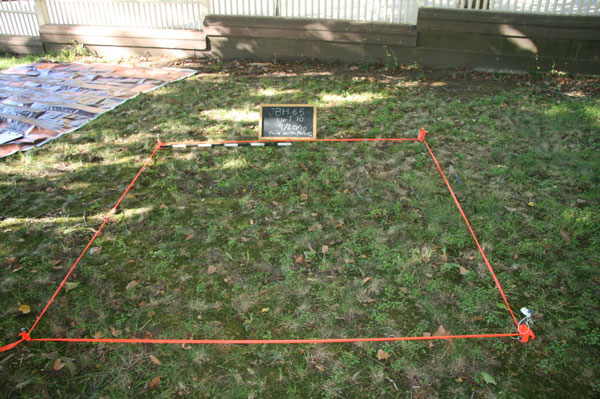
Unit 10: They began by laying out a tarp (to contain backfill). Then Krysta came over and helped the group string orange tape around the square to define the unit’s boundaries to help prevent someone from stepping into it or knocking over the stakes. They then shaved off the top 2 cm (approx.), which largely consisted of moss and grass. The soil was dry, dark brown, and slightly sandy. Some small, fibrous roots are running through the plot, but they were able to work around these without having to utilize the root-saw. The soil was placed into plastic buckets, and was then sifted using the large-frame sieve. This continued until approximately 4 centimeters were shaved off. The findings of the sifting were 21 rocks, 2 small pieces of glass (one green, one brown, likely from beer bottles, both approximately 0.5cm squared), a small piece of plastic (approximately 0.5cm squared), and a wooden core (approximately 1cm long, 0.4cm diameter). These were put into a Ziploc sandwich bag and then given to Krysta to be stored in a larger artifacts bag. All of the soil that had been removed from the plot was left on the tarp.
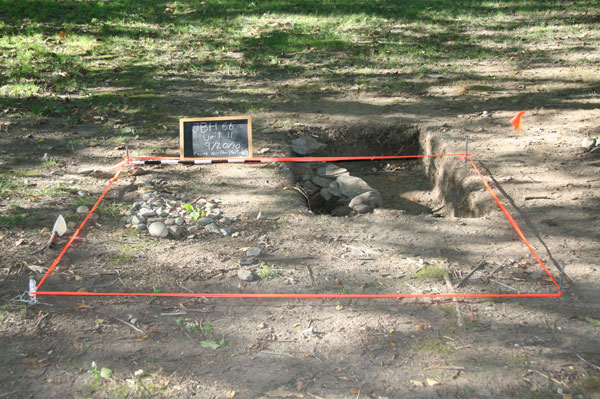
Unit 11: The group from site 11 has nicknamed themselves “7-11’s.” They continued to unbackfill the plot. As a group, they examined the unit and, realizing that the soil on the western side of the wall had a great deal of rocks and rubble, they decided to place the new unit on the southwest side of Unit 7 in order to try to catch the edge of the wall, as well as investigate the rubble. Once the site was laid out using stakes and orange ribbon, the elevation was taken along with the measurements of the four points of the unit, finding the highest elevation stake and marking it as their “datum” point for the unit. They then recorded the topographical features of the plot and took photos of the site in the manner described above. They noted that the soil was rocky where the digging had been the previous year, and the new area was described as having “very small patches of moss, mostly soil with a few roots.” They slowly and carefully shaved off layers of dirt, and at the end of the day had recovered one artifact: a rusty beer cap.
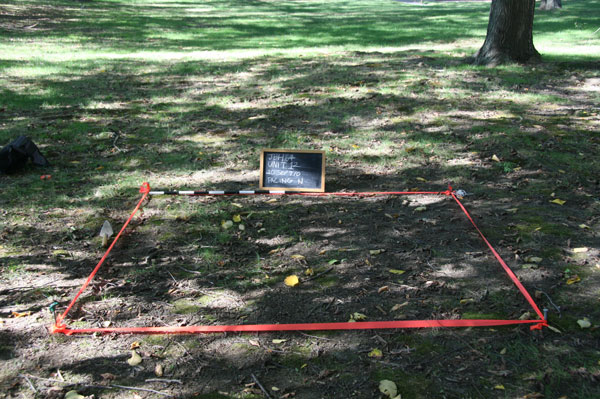
Unit 12: The group at Unit 12 began in a very similar manner as the other groups, laying out the orange ribbon and photo-documenting the site. Then they carefully surveyed the ground surface and found several items, including a Bud Lime cap in the plot’s northeast corner, mouse remains also in the northwest corner, and a candy wrapper in the middle toward the southwest corner. The soil in this site was dark brown, rich, and loose. The group found the actual digging process very difficult because of the 0.5cm-diameter roots that run throughout the plot. They made good use of the root-saw! It was also difficult to shave the top dirt layer because the soil was so soft. Despite these challenges, they had a rewarding day. The group found a great variety of man-made objects while sifting. These items include a Corona beer cap, several terra cotta-glazed wooden strips, foil wrapper, clear plastic wrapper, blue and white glazed ceramic sherd, clear glass sherd, purple fuzz, a small white feather, and seed pods. By the time they had finished digging they had shaved off approximately 10 cm of soil, revealing a layer of hard-packed soil or clay to be tackled next week.
At 5:20 we all packed up the supplies and returned them to the Carriage House. We then walked to the Joukowsky Institute, where Jessica led our discussion section. We focused primarily on the Mary Beaudry article, as well as how we felt it compared to a (very scientific) report from the National Parks Service. We discussed the role of personal interpretations and bias and whether they should be included with the data or kept separate, to keep the data “pure.” This raised questions about whether data is ever “pure,” and whether or not there is inherent bias (stemming from a researcher’s specific goals and questions) when a person records data. We also discussed the advantages and disadvantages of reports taking a narrative approach or being written more scientifically.
Week 3 and 4: Excavation and Unit Summaries (Nick and Cindy)
Week 3
Excavations were suspended this week. Instead, we received fantastic tours of both the Rhode Island Historical Society Library and the inside of the John Brown House.
Week 4
In order to make up for our absence last week, we quickly divided into our unit groups and began excavation. As always, we dug carefully and evenly, recording any changes in context or artifacts. Our excavation forms, field blogs, and photo library serve as the main source of documentation.
Unit 10: The Unit 10 group continued to work on their primary context but had several issues in their way. The soil was wet, changing its appearance, rocks were abundant, and roots were extensive, which made it difficult to dig. This seems to be a common problem in all units. As they shoveled a few more inches off, they began to see mottling (5 inches down) and expect to begin a new context next time. They were able to define their walls clearly and found several artifacts: glass shards, piece of white styrofoam, bead, pieces of ceramic and porcelain, chips of slate and terra cotta chips.
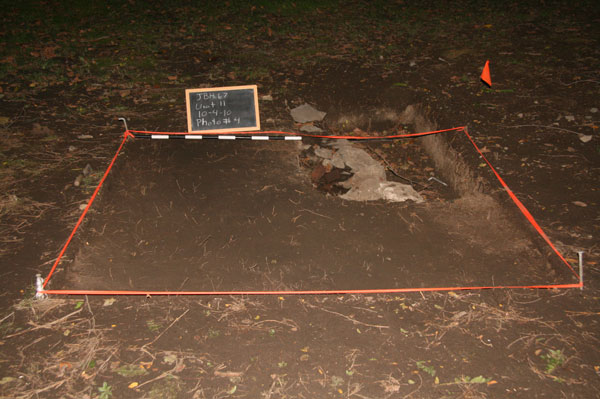
Unit 11: Still excavating the primary context, the Unit 11 group battled stringy roots and a wet dirt layer (due to the precipitation the day before). About midway through the class period, the group discovered a significant amount of gravel in the northwest corner of the unit. Because gravel is often the sign of a crumbled wall foundation and other forms of occupation, the existence of gravel was a welcomed discovery. Furthermore, the excavators of Unit 7 last year (Unit 11 is a continuation of Unit 7), had noticed more gravel on the west side of the wall than on the east side. Thus, the Unit 11 group verified these results. The group then spent the remainder of the class period excavating evenly across the unit, noting that gravel appeared throughout the site. In addition to finding widespread gravel, the Unit 11 group discovered a few more artifacts in the first context: part of a Solo cup, a rusty bottle cap, a nail, and three ceramic pieces of different varieties. Finally, after evening out the sides of the unit and clearing large roots (many of which required the use of a root saw), the Unit 11 group measured the elevations of the new context while also documenting using photos and an excavation form.
Unit 12: At the end of last session, the Unit 12 group began to see soil that appeared to be softer and different in colour in the north-west corner, and questioned whether or not it was a new context. This week, they evened out the primary context to determine if this new type of soil could be found throughout the entire unit or if it was confined to the north-west corner. Although they did find that the soil began to change appearance at this depth throughout the entire unit, with the help of Krysta, they declared that it was not a new context because there was a higher probability that the soil was just condensed. They found it really difficult to dig this week as there were extensive root systems throughout the entire unit. Most of the session was dedicated to evening out the primary context, making clearly defined walls, breaking up the root systems and shoveling a few more centimeters off. They found more artifacts this week, including a fairly large piece of brick, an iron nail, white stones and pieces of slate.
Section: In section, the class continued to discuss the relevance of historical documents in archaeology. By using the readings as examples, the class debated whether or not historical documents can serve as a primary means of evidence or whether they can only slightly supplement the material record. Further discussion included the role a single site can play on the interpretation of a larger culture. To what extent does a larger culture influence a household? Does this household in turn influence the culture? Is this interpretation relevant to the archaeological record? Finally, as an exercise in primary sources, the class divided into three groups and receive four pictures or maps of the John Brown house from different time periods. The purpose of the exercise was to see how various forms of primary documents can not only highlight attitudes toward documentation during the time period, but also how they can come together to give archaeologists a better picture of how a site adapts. No doubt, we will be using these new skills when completing of final reports.
Week 5 Excavation and Unit Summary (Ben and Evie)
Returning after two weeks off due to fall weekend, we started off with a tour of the various units and checked in with what our classmates had been doing, and videodocumenting each site's progress. We then set to work digging. There was an additional day of digging for some units on the Saturday of family weekend, when some of the class came in to excavate to make up for lost time and as an exhibition for the interested families.
Unit 10: The Unit 10 team started off their day's digging by putting on music while they cleared the accumulated leaves and remaining topsoil off their plot to expose their new context; the layer of "calico" soil about 5" down. After photographing and recording the new context, they set to work shovel scraping the new layer. The shoveling team quickly began turning up interesting artifacts; first a bent pre-1900 nail, then a fragment of a porcelain pipe. The pipe turned out to be an important find, as it contained the part of the bowl that has the maker's mark, making it possible to trace the pipe's manufacturer. Apparently, most pipe fragments found at the JBH are chips of bowl edges or pieces of the stem, and do not have this diagnostic feature. The shovels soon began to hit stone, and the team shifted to excavation with trowels and brushes in order not to disturb any architectural features that might be buried in the unit. They began to uncover groups of stones surrounded by mortar and nails, and patches of brick dust, evidence that there may be some kind of architecture under the unit. There was little depth progress after reaching the new context, as the soil was rocky, and the trowel digging was much slower, but the number of artifacts uncovered makes the day's work interesting. No one from the unit was present on family weekend, so no progress was made during Saturday's excavations.
Unit 11: Unit 11 began by redoing their level measurements for their new context, and using the Munsell chart to record their soil color. After resuming their excavation, they began unearthing a large amount of gravel, mixed with larger stones. The excavation of the gravel led to a new soil color, a patchy orange soil, in the center of the unit. After finding pieces of brick and larger stones in this new layer, they set to work evening out their plot, in case they had found a new context. This excavation revealed a row of large stones running parallel to the previously excavated Unit 7 wall. Excavation to either side of this row showed that it was in fact a second wall, right next to and parallel to, the previously uncovered one. The rest of the excavation period was spent trying to uncover and define the limits of this new wall. The uncovering of the wall yielded many artifacts, including tile, nails, ceramics, and charcoal. At the end of the day, the unit included about five new contexts to account for the differences between the soil composition between and outside the walls. Between the walls appears to be largely fill items, like bricks and mortar. Outside the double row to the west is plain dirt, while to the east is the mottled soil that signaled the day's first new context.
Unit 12: Unit 12 began by dealing with the root problem that has plagued their investigation from the start. After sawing off the roots that had grown in the two week hiatus, they excavated down until the unit displayed a mottled, clay-like layer similar to the one found in units 10 and 11. Sifting the dirt removed uncovered many pieces of blue and white glazed pottery, much of which appears to belong to a single plate, coal dating to after 1860 (which may suggest the unit was disturbed at some point in the past, as things that appear to be from different times are interspersed), and many nails and pieces of glass. After recording their new context, the Unit 12 team began excavating again and uncovered a wealth of large rocks, interspersed with pieces of marble (remnants of the fountain?), pottery fragments, and pieces of glass, one of which had an "S" printed on it, which will be useful in determining what it was. Professor Ryzewski explained the unusual patchy appearance of the soil and perhaps the anachronistic nature of some of the artifacts by revealing that it is possible that the Unit 12 group is digging up backfill soil poured into the hole created when the fountain was removed. If this is the case, the Unit 12 location was well chosen, as it must be nearly on top of where the fountain once stood.
Section: After returning to the Joukowski Institute, we discussed the role that outside evidence may play in archaeology and the extent to which archaeology can be a "hard" science. Many points were well-made about the subjective nature of the field and the issues involved in keeping excavations orderly while at the same time making sure data is handled by those who know most about the topic. Who knows most? The excavator or a specialist? These questions were played with in group discussion. Professor Ryzewski gave an introduction to the final project, and instructed us to start thinking about topics.
Parents Weekend Excavation and Unit Summary: October 23, 2010
Unit 10: Closed
Unit 11: Unit 11 began by evening out the unit and exposing the extent of the potential new contexts as well as defining the extent of the wall that was uncovered in week 5. During the course of the excavations in the southeast corner of the unit rectangular blocks of intact tile wer unearthed. The blocks of tile matched the type of the many disarticulated tiles that had been found in the unit.
Unit 12: Unit 12 contains soil that is relatively fine and sandy with few inclusions or potential for features so as a result they began by moving large amounts of soil relatively quickly. They proceeded at the same pace through the course of the day and at increasing depth, but wth no evidence of a new context.
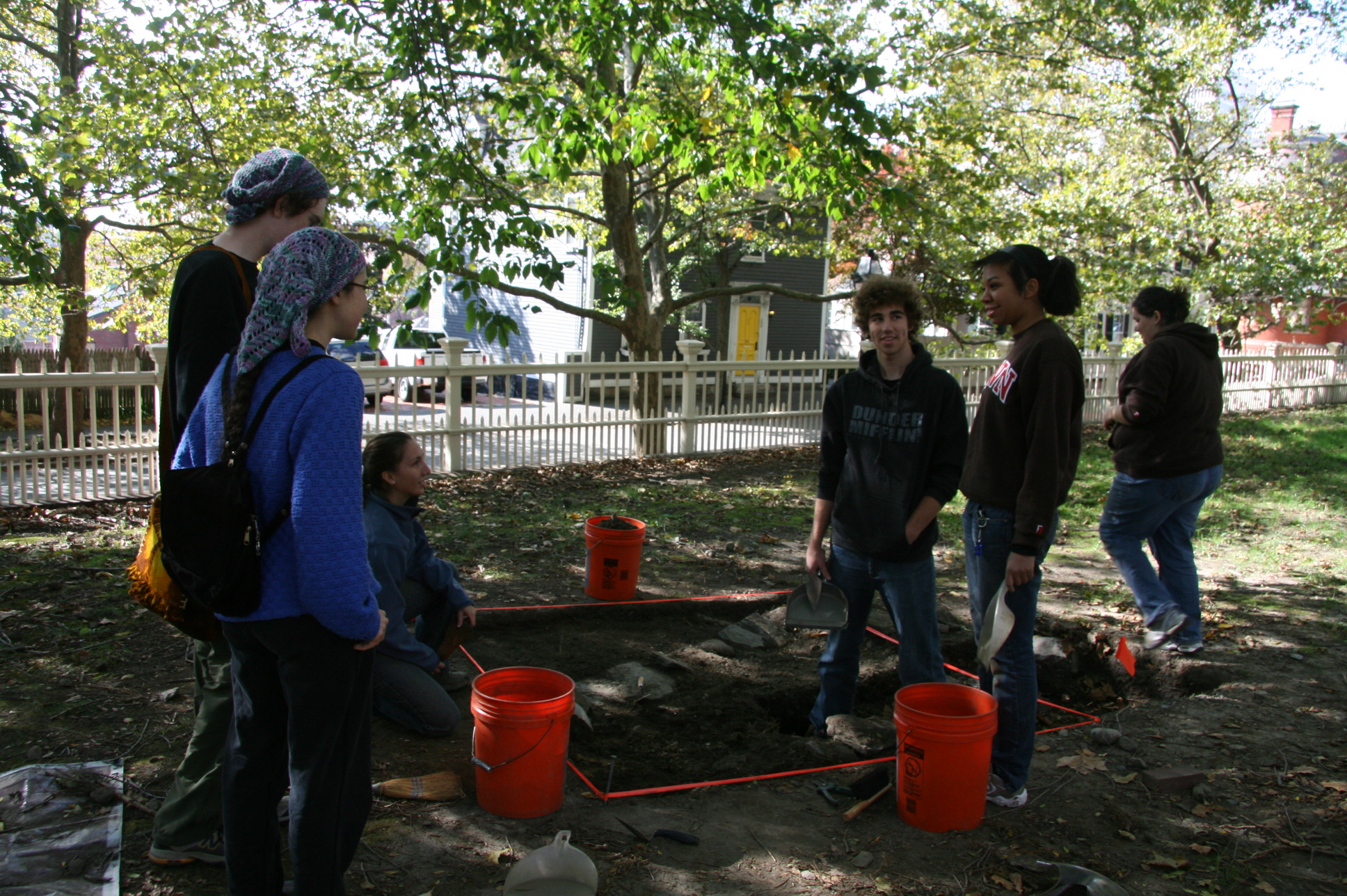
Week 6 Excavation and Unit Summary: October 25, 2010
Unit 10: Continued digging through context 68 consisting of mottled Brown and orange soil.
Unit 11: Unit 11 Began by documenting three new contexts 70,71 and 72. Context 70 is a triangular shaped context located in the western most portion of the unit. It contains soil that is darker in color ( Munsell: 5y/2.5/1) than the other areas of the unit and has few inclusions. The area was trowelled and sifted prior to being photographed (photo 7). After the photo was taken it was shoveled heavily due to the fact that it has few inclucions and little potential for a feature or artifacts. Context 71 is the wall in the western portion of the unit that separates context 70 from context 72. The wall runs parallel to feature 2 (wall from unit 7 in previous field season excavations). The wall is Northwest to Southeast in orientation and is composed of large rocks with a specific area that is mortar without rock. The context was photographed (photo 8) and was given the feature number 4. Context 72 is located in the center of the unit between feature 4 and feature 2. It is composed of mottled soil that is orange and light brown in color (Brown Munsell: 10yr/2/2; Orange Munsell 2.5yr/5/6). This context contains many inclusions varying in size and type. There were large pieces of mortar found in the center north portion of the context. The intact tile that was uncovered in the southeast corner of the unit during parents weekend excavations was also documented and photographed in this context (photo 10). Also in the unit a hole was discovered near the location of the intact tiles in the southeastern corner.
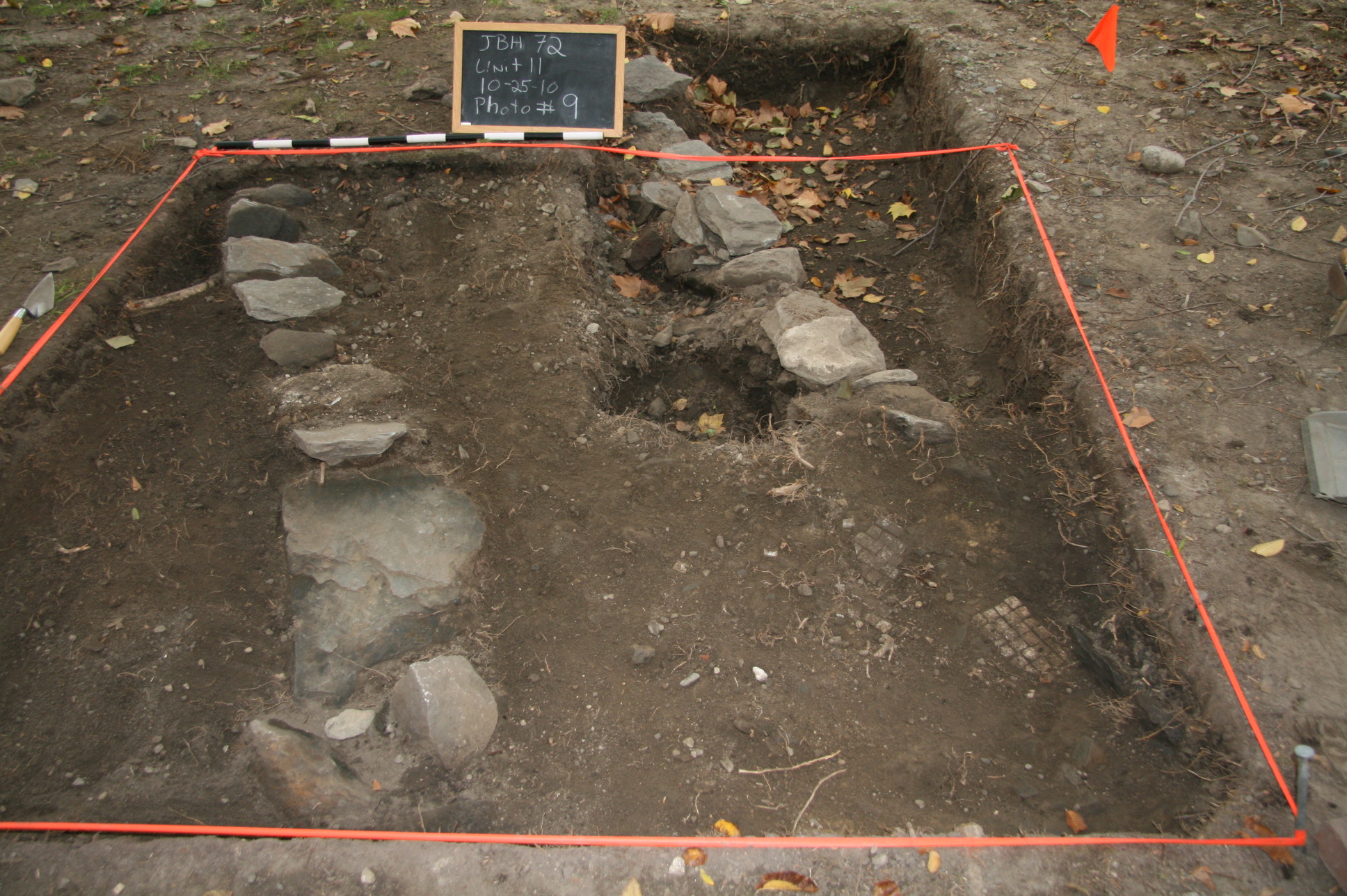
Unit 12: Continued digging through context 69 which is a mottled clay layer. A sprinkler was found in the southern portion of the unit preventing continued excavation in that portion of the unit. Many artifacts were found several of them ceramic with elaborate designs.
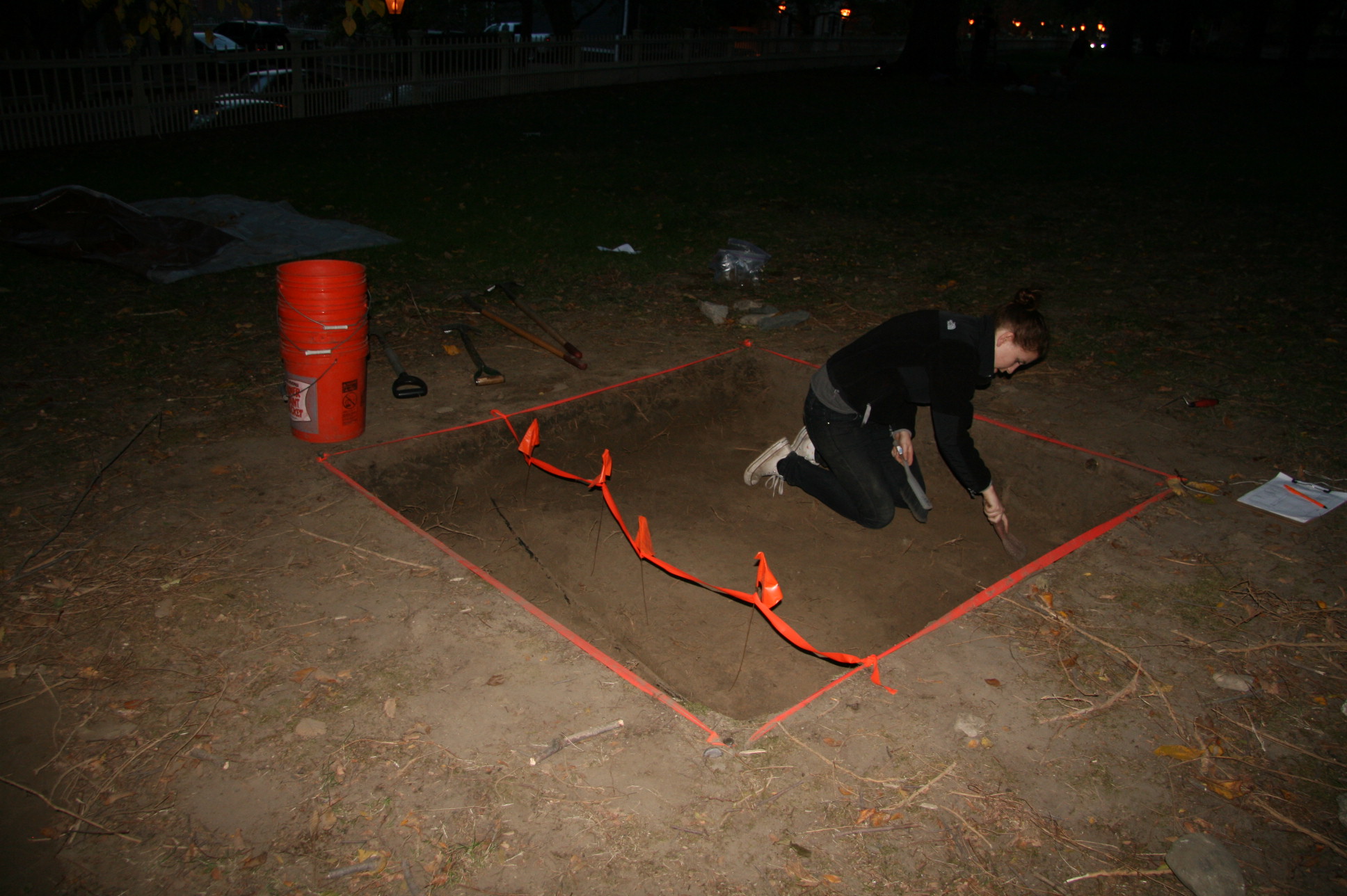
Week 7 Excavation and Unit Summary: November 1, 2010
Unit 10: Unit 10 continued digging through context 68 and found a variety of artifacts. The most noteable which was an intact perfume bottle found near the center of the unit. A new context was also documented, context 73. The context is located in the Northeastern corner of the unit and consists of large stones with pieces of iron. The context was given feature number 5 and was photographed (photo 15, 16). The soil is darker in color than the previous context.
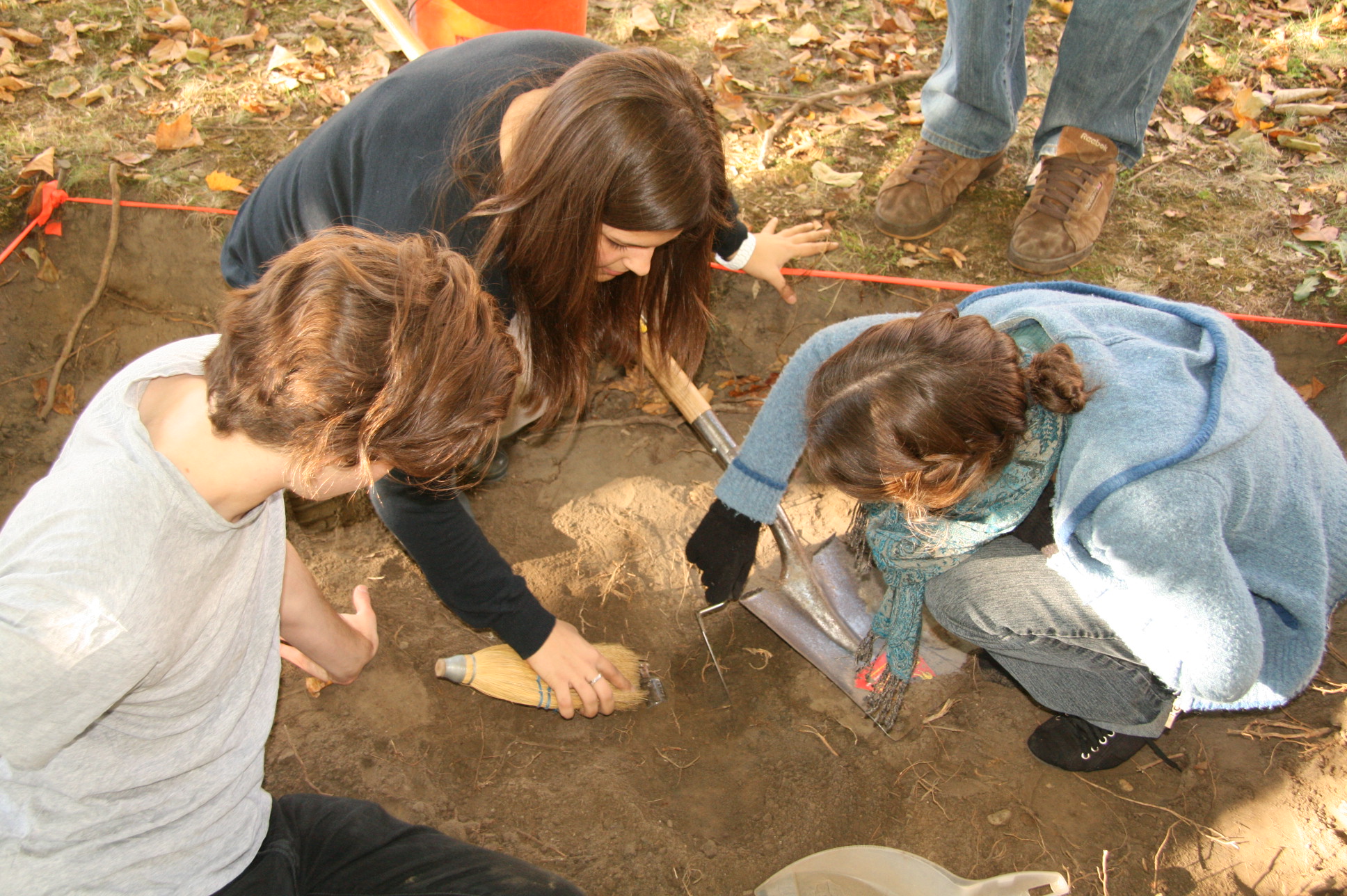
Unit 11: Unit 11 continued excavating and exposing the extent of the three new contexts while paying particular attention to context 72. The area was trowelled and sifted which produced large amounts of tile and nails within context 72. Near the center of the context more intact tile was found. Two distinct tile types emerged when they were compared. A portion of the tile found in the unit was whiter and more chalky in composition, while the second type of tile was smoother and appeared to be more marble like in composition. More holes were found in the southeaster portion of the unit, and they appear to be connected.
Unit 12:Unit 12 continued excavations through context 69 and found a number of artifacts notebly a tooth, various ceramic pieces, and a portion of a bottle. Patches of fertilizer continue to appear in the unit.
Week 8 Excavation and Unit Summary: November 8, 2010 (Olivia and Max)
This week, it was drizzling, cold, and overcast for the first hour of class. Unfortunately, it started pouring around 3:45pm. Krysta’s assertion that this week was “extreme archaeology” was no lie.
Unit 10: Unit 10 continued digging in context 73 by breaking down the architectural feature. The soil in context 73 is the same dark brown as in context 68, but is slightly mottled with dark brown/black inclusions. The archaeologists unearthed iron nails, large iron chunks and bricks with mortar attached. The soil was loosely packed, supporting the group’s suspicion that their unit was a dump spot. In clearing the feature away, the archaeologists uncovered many of the same types of iron nails, shells, mortar, and small chunks of brick. Under the feature, the soil was more tan and packed. But, once the first layer of the feature was removed, the bricks and stones were oriented randomly, indicating that the assumed wall is indeed not a wall, further supporting the group’s suspicion that the area was a trash dump.
Unit 11: The archaeologists of Unit 11 observed a downfall of bricks along western side of the exposed wall. In context 70, they found two pieces of pottery. In context 72, the archaeologists unearthed many flat rocks. In the same context, layers included stone, mortar, concrete, brick, and stone. After uncovering the “hole” at the southern end of the wall by removing a giant rock, the group removed soil from the hole for further analysis.
Unit 12: The archaeologists of Unit 12 were upset that Monday was the last day of digging. When they arrived, the tarp was covered in water. Unfortunately, in moving the tarp, much of the water was dumped and the unit flooded. The archaeologists were required to bail out the unit with buckets, a la small sailboat. This dampness made the soil easier to remove but significantly more difficult to sift. To sift such wet soil, dry dirt was needed to soak up some moisture from the mud. In this process, several pairs of gloves were ruined, as digging through the cold wet dirt with bare hands was a sure recipe for hypothermia. They uncovered glass, pottery, and more iron nails. Eventually, digging reached a new context, which Krysta said was a glacial till deposit, indicating the end of human contexts, aside from Paleolithic Native Americans who may have interacted with this glacial till context. Approximately 30 minutes before sunset, the Unit 12 archaeologists trowelled in a last ditch effort (no pun intended) to excavate as much as possible before having to backfill next week.
After digging, the class went back to the lab in the carriage house to wash and dry artifacts. The process begins by separating metals and mortar from other, washable objects. Bone is a special category, as it can be washed but must be handled with care lest it disintegrate. So, washable objects (pottery, class, stoneware, etc.) were toothbrush scrubbed in tubs of water and placed on screens to dry. To stay organized, it is important to only wash artifacts from a single context at any given time. This process will continue next week, as there was not enough time to prepare all of the artifacts.
